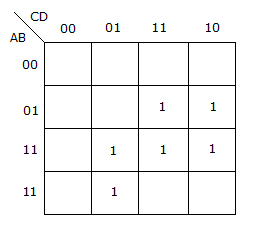ECE :: Digital Electronics
-
In a digital counter the number of flip-flops is
-
Assertion (A): Gray code is used in shaft position encoding.
Reason (R): In gray code only a single bit change occurs when going from one code to another.
-
For the K map of the given figure the simplified Boolean expression is

-
The term VLSI generally refers to a digital IC having
-
Which of the following memories normally has highest storage capacity?
-
The number of comparators of needed in a parallel conversion type 8 bit A to D converter is
-
Assertion (A): In hybrid digital circuits the problem of logic race can occur.
Reason (R): In two level logic there is no problem of logic race.
-
The characteristic equation of an SR flip-flop in given by


 Whatsapp
Whatsapp
 Facebook
Facebook

